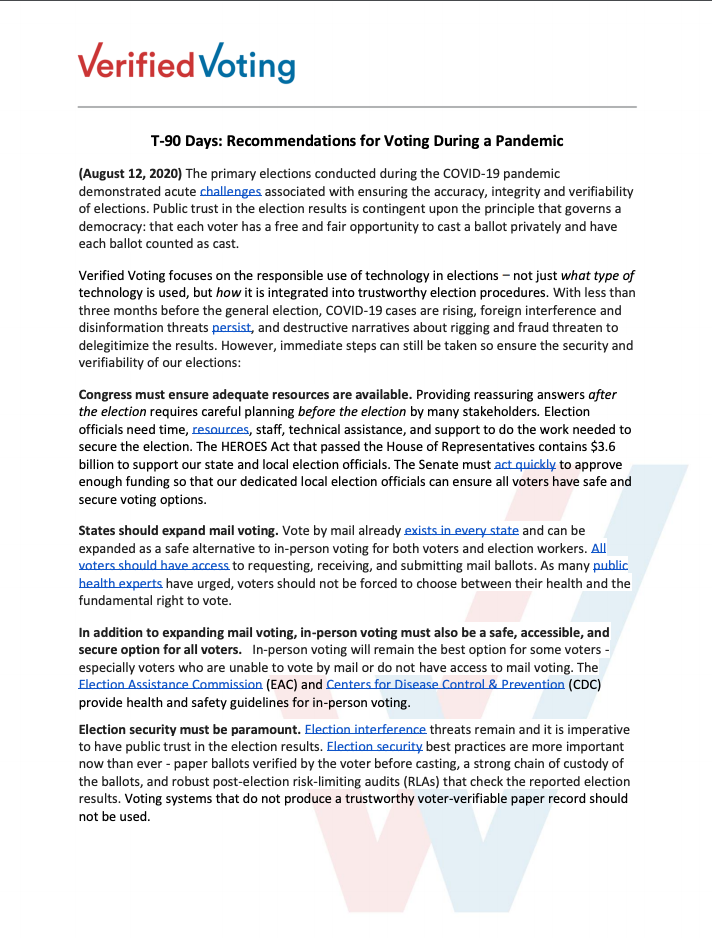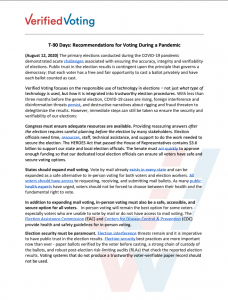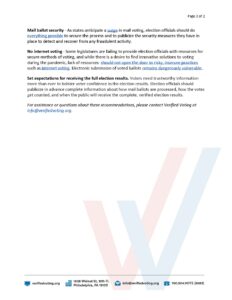
resource
T-90 Days: Recommendations for Voting During a Pandemic
Date: August 12, 2020
Author: Verified Voting
Issue: Voting Equipment, Post-Election Audit, Paper Records, Internet Voting, Election Security
Publication Summary
With less than three months before the general election and amidst a global pandemic, here’s what can still happen to ensure the security and verifiability of our elections.
The primary elections conducted during the COVID-19 pandemic demonstrated acute challenges associated with ensuring the accuracy, integrity and verifiability of elections. Public trust in the election results is contingent upon the principle that governs a democracy: that each voter has a free and fair opportunity to cast a ballot privately and have each ballot counted as cast.
Verified Voting focuses on the responsible use of technology in elections – not just what type of technology is used, but how it is integrated into trustworthy election procedures. With less than three months before the general election, COVID-19 cases are rising, foreign interference and disinformation threats persist, and destructive narratives about rigging and fraud threaten to delegitimize the results. However, immediate steps can still be taken so ensure the security and verifiability of our elections:
Congress must ensure adequate resources are available. Providing reassuring answers after the election requires careful planning before the election by many stakeholders. Election officials need time, resources, staff, technical assistance, and support to do the work needed to secure the election. The HEROES Act that passed the House of Representatives contains $3.6 billion to support our state and local election officials. The Senate must act quickly to approve enough funding so that our dedicated local election officials can ensure all voters have safe and secure voting options.
States should expand mail voting. Vote by mail already exists in every state and can be expanded as a safe alternative to in-person voting for both voters and election workers. All voters should have access to requesting, receiving, and submitting mail ballots. As many public health experts have urged, voters should not be forced to choose between their health and the fundamental right to vote.
In addition to expanding mail voting, in-person voting must also be a safe, accessible, and secure option for all voters. In-person voting will remain the best option for some voters – especially voters who are unable to vote by mail or do not have access to mail voting. The Election Assistance Commission (EAC) and Centers for Disease Control & Prevention (CDC) provide health and safety guidelines for in-person voting.
Election security must be paramount. Election interference threats remain and it is imperative to have public trust in the election results. Election security best practices are more important now than ever – paper ballots verified by the voter before casting, a strong chain of custody of the ballots, and robust post-election risk-limiting audits (RLAs) that check the reported election results. Voting systems that do not produce a trustworthy voter-verifiable paper record should not be used.
Mail ballot security – As states anticipate a surge in mail voting, election officials should do everything possible to secure the process and to publicize the security measures they have in place to detect and recover from any fraudulent activity.
No internet voting – Some legislatures are failing to provide election officials with resources for secure methods of voting, and while there is a desire to find innovative solutions to voting during the pandemic, lack of resources should not open the door to risky, insecure practices such as internet voting. Electronic submission of voted ballots remains dangerously vulnerable.
Set expectations for receiving the full election results. Voters need trustworthy information more than ever to bolster voter confidence in the election results. Election officials should publicize in advance complete information about how mail ballots are processed, how the votes get counted, and when the public will receive the complete, verified election results.
For assistance or questions about these recommendations, please contact Verified Voting at info@verifiedvoting.org.

